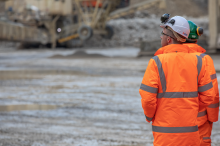
While cement accounts for a small part of the volume of concrete, it is almost entirely responsible for concrete's carbon emissions. Cement production is not only energy-intensive, but its inherent chemical reaction – calcination - releases gaseous CO2. Efforts on fossil fuel substitution and energy efficiency improvements have been spent to tackle power-related emissions. Preventing CO2 release from the calcination reaction is trickier, but innovative solutions such as carbon capture and utilisation (CCU) can enable low- and even negative- carbon concrete.
IDTechEx's recent report "Carbon Capture, Utilisation and Storage 2021-2040" explores the technical and commercial aspects of CCU, and its potential to mitigate CO2 emissions.
The CO2 produced during the calcination reaction can be captured at point-source to be either stored safely underground (carbon storage) or used for a range of industrial applications (carbon utilisation), including concrete manufacturing. These carbon capture, utilisation, and storage (CCUS) technologies are likely to play a key role in the fight against climate change. The UN estimates that CCUS could mitigate between 1.5 and 6.3 gigatonnes of CO2 equivalents per year by 2050.
Though CCUS technologies do exist commercially, they will need to scale up hundreds of times to have a meaningful impact on global emissions. As CO2 storage has no business model without a regulatory framework, CO2 utilisation could boost the economic feasibility of CCU. However, for captured CO2 to be widely utilised as a raw material, CO2 marketplaces and distribution infrastructure will need to expand accordingly.
Using the CO2 captured on-site as a feedstock for concrete manufacturing could be an effective way to come full circle. A promising solution that applies this principle is carbon-cured concrete. In CO2-curing, captured CO2 is injected to accelerate the process, strengthen the concrete, and sequester the CO2 into the end-product.
The Montreal-based cleantech CarbiCrete uses this CO2-curing method to produce carbon-negative precast concrete blocks. The negative emissions are achieved not only by utilising CO2 but also by using an industrial waste as raw material, steel slag, eliminating the need for cement. A more modest carbon footprint reduction of around 5% is promised by CarbonCure, although its technology has a broader market penetration, spanning both precast and ready-mix concrete. The company is also using captured CO2 to strengthen recycled concrete aggregate (RCA) and to treat concrete wash water to allow for its reuse.
Another Canadian startup, Carbon Upcycling Technologies (CUT), makes additives for concrete by incorporating CO2 into industrial waste powder by-products such as fly ash. CUT's resulting CO2-enhanced fly ash promises to improve concrete strength whilst reducing its carbon footprint by up to 25% through sequestering CO2 and decreasing the demand for cement as a raw material by 10%.
Although some of these technologies promote reductions in operational and raw material costs, sourcing captured CO2 is likely to increase the overall price of the final product. With the appropriate policy incentives and cost reductions that come with large-scale implementation, this "green premium" can be reduced, giving the edge needed for these low-carbon concrete alternatives to take off.
Concrete manufacturers face growing pressure to abate their emissions, even though the economic advantages are still uncertain. To capitalise from CCU technologies, concrete makers will need to commit to fundamental changes in their well-established manufacturing methods, which may involve lofty investments and partnerships with unfamiliar players, such as carbon capture companies and innovators licensing CO2 utilisation solutions. Forward-thinking players are likely to future-proof their business as they focus on both profits and sustainability.
For a more detailed analysis of the technological and economic factors in the CCUS industry over the next twenty years, please visit www.IDTechEx.com/CCUS.









